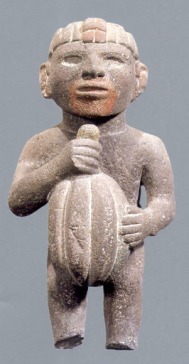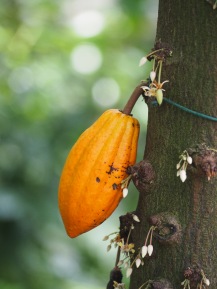I’m a massive fan of dark chocolate. There’s just something about that rich flavour and silky texture that draws me in. Not everyone shares my taste though. Some have a soft spot for white chocolate, but most opt for the widely available milk chocolate.
The ingredients of chocolate are few: sugar, milk (either milk powder or condensed milk), fat (either cocoa butter or vegetable oil), and cocoa solids (fibre). Dark, milk, and white chocolate all have a slightly different mix of ingredients – dark chocolate is free of milk, white chocolate lacks cocoa solids, and milk chocolate has varying portions of everything.

Aztec holding cacao pod; Photograph: Brooklyn Museum
Such large variety of chocolate recipes is a relatively recent phenomenon, despite the history of cacao consumption dating back to 1900 BC, when the Olmecs, Mayans, and Aztecs had it as an unsweetened drink. Christopher Columbus introduced the cacao drink to Europe in the early 1500s. It slowly gained acceptance as honey and sugar was added to mask the natural astringency of the beans. Methods were developed to adapt the taste and the first solid chocolate bars were produced by Fry’s of Bristol in 1947.
The insatiable demand for chocolate in its wide and varied forms is possible only through the supply of cacao beans by Ghana and Côte d’Ivoire, which account for majority of global production. Cacao nibs that are ground and pressed to produce cocoa solids and cocoa butter are the dried and fully fermented seeds of the cacao tree, Theobroma cacao. There are three main varieties of cacao trees: Criollo, Forastero, Trinitario.

Photograph of ripe Forastero cacao pod taken by Cloudpot in Botanical Gardens of The University of Heidelberg
Criollo is the original rare and exquisite variety, Forastero is the most versatile and accounts for over 80% of global production, and Trinitario is a hybrid of the other two varieties. These trees are small understory trees that are very sensitive to climatic conditions – they need well-drained soils, 2000 mm of rainfall per year, and temperatures between 21 to 32 °C. Thus, they’re naturally grown in countries close to the equator. Countries like Indonesia, which have the right climatic conditions for growing cacao trees, have been trying to increase production of the crop to capture a share of the growing global market. There are over 1.5 million hectares of cacao farms across multiple islands of the archipelago (Sulawesi, Sumatra, Kalimantan, Java); these are managed mostly smallholder farmers, but also include large plantations and private estates.
The chocolate making process starts with the harvest of ripe cacao pods. The seeds inside are what farmers are most interested in. Cacao seeds naturally have an intense bitter and astringent taste so must be fermented to develop the characteristic cocoa flavour. The pulp surrounding the cacao seed is composed water, sugars, and acids, and is the fermentation target of yeasts, bacteria, and enzymes.
There are two key phases to the fermentation process: anaerobic and aerobic. The sugars and acids are broken down to produce liquid run-offs known as ‘sweating’ during the anaerobic (free of air) phase of the fermentation process. This frees up space for air and lowers the pH to facilitate the aerobic (with air) phase. Farmers turn the beans to incorporate air in the mixture. This helps to create a more uniform fermentation product. Certain bacteria oxidise ethanol and acids to produce acetic acid which is then broken down into carbon dioxide and water by oxygen in the air. The breakdown of ethanol is an exothermic process that produces heat, while the turning and mix cools the temperature of the beans. This combination of heat and diffusion of ethanol and acetic acid into the cacao bean degrades cell walls, thus damaging the structure and facilitating the development and incorporation of desired flavour precursors in the cacao bean.
After fermentation, the seeds are dried, cleaned, and roasted. The husk is removed to produce cacao nibs that are ground to cocoa mass. Cocoa mass is melted (by heat) to form chocolate liquor. Chocolate liquor can be processed to two forms: cocoa butter and cocoa solids.
The rest is up to the chocolatiers – may the Pektuzuns keep working their magic!
-end-





Interesting article! I love dark chocolate too!
Thanks!